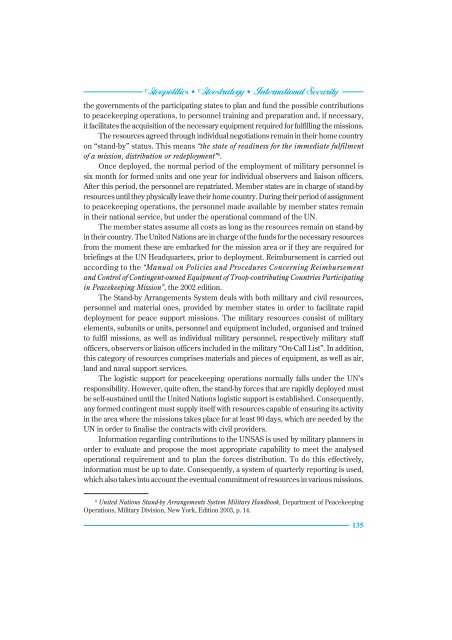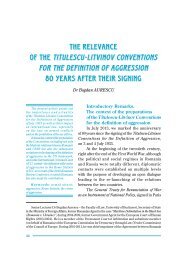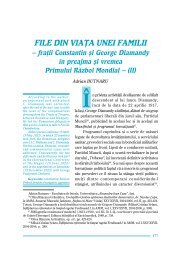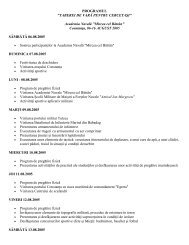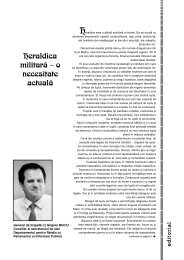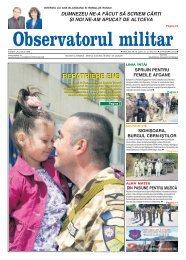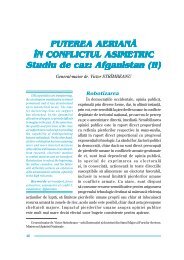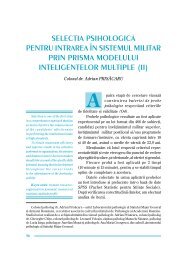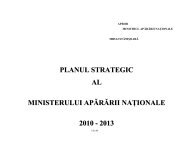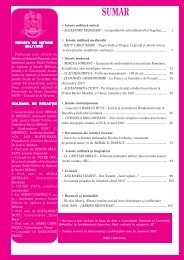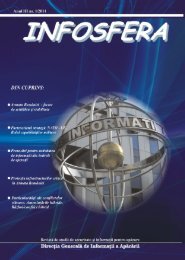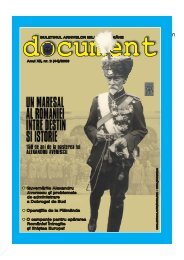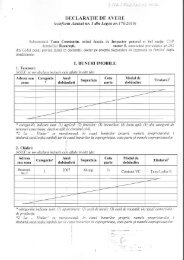Romanian Military Thinking
Romanian Military Thinking
Romanian Military Thinking
Create successful ePaper yourself
Turn your PDF publications into a flip-book with our unique Google optimized e-Paper software.
Geopolitics • Geostrategy • International Security<br />
the governments of the participating states to plan and fund the possible contributions<br />
to peacekeeping operations, to personnel training and preparation and, if necessary,<br />
it facilitates the acquisition of the necessary equipment required for fulfilling the missions.<br />
The resources agreed through individual negotiations remain in their home country<br />
on “stand-by” status. This means “the state of readiness for the immediate fulfilment<br />
of a mission, distribution or redeployment” 6 .<br />
Once deployed, the normal period of the employment of military personnel is<br />
six month for formed units and one year for individual observers and liaison officers.<br />
After this period, the personnel are repatriated. Member states are in charge of stand-by<br />
resources until they physically leave their home country. During their period of assignment<br />
to peacekeeping operations, the personnel made available by member states remain<br />
in their national service, but under the operational command of the UN.<br />
The member states assume all costs as long as the resources remain on stand-by<br />
in their country. The United Nations are in charge of the funds for the necessary resources<br />
from the moment these are embarked for the mission area or if they are required for<br />
briefings at the UN Headquarters, prior to deployment. Reimbursement is carried out<br />
according to the “Manual on Policies and Procedures Concerning Reimbursement<br />
and Control of Contingent-owned Equipment of Troop-contributing Countries Participating<br />
in Peacekeeping Mission”, the 2002 edition.<br />
The Stand-by Arrangements System deals with both military and civil resources,<br />
personnel and material ones, provided by member states in order to facilitate rapid<br />
deployment for peace support missions. The military resources consist of military<br />
elements, subunits or units, personnel and equipment included, organised and trained<br />
to fulfil missions, as well as individual military personnel, respectively military staff<br />
officers, observers or liaison officers included in the military “On-Call List”. In addition,<br />
this category of resources comprises materials and pieces of equipment, as well as air,<br />
land and naval support services.<br />
The logistic support for peacekeeping operations normally falls under the UN’s<br />
responsibility. However, quite often, the stand-by forces that are rapidly deployed must<br />
be self-sustained until the United Nations logistic support is established. Consequently,<br />
any formed contingent must supply itself with resources capable of ensuring its activity<br />
in the area where the missions takes place for at least 90 days, which are needed by the<br />
UN in order to finalise the contracts with civil providers.<br />
Information regarding contributions to the UNSAS is used by military planners in<br />
order to evaluate and propose the most appropriate capability to meet the analysed<br />
operational requirement and to plan the forces distribution. To do this effectively,<br />
information must be up to date. Consequently, a system of quarterly reporting is used,<br />
which also takes into account the eventual commitment of resources in various missions.<br />
6 United Nations Stand-by Arrangements System <strong>Military</strong> Handbook, Department of Peacekeeping<br />
Operations, <strong>Military</strong> Division, New York, Edition 2003, p. 14.<br />
135


